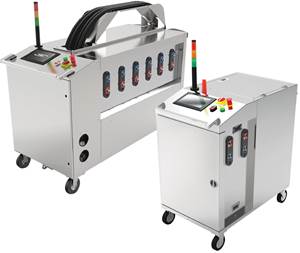On the Cutting Edge in Structural Foam
In structural foam, as in any area of plastics, keeping abreast of the latest technology is a key to competitiveness.
In structural foam, as in any area of plastics, keeping abreast of the latest technology is a key to competitiveness. For 20/20 Custom Molded Plastics Ltd. in Holiday City, Ohio, that has meant using independent multi-nozzle injection control and robotic parts handling. “It is surprising, but the majority of structural-foam molders today still do not have these latest advantages, so they are falling behind,” says 20/20 president Ron Ernsberger.
His firm’s 90,000-sq-ft plant houses five structural-foam presses from Uniloy Milacron, Tecumseh, Mich. They range from three 500-tonners to a 1000-ton machine and a 1500-ton behemoth said to be the largest in the country. It can run up to 5000 lb/hr, and the whole plant can consume 300,000 lb/day. “We have the highest structural-foam tonnage and capacity of any custom molder,” claims Ernsberger. Foam makes up more than 80% of the firm’s $25 million sales. The rest is structural-web molding and standard injection molding (on four presses of 375 to 726 tons).
Multi-nozzle control
“We sell machine time, so getting as many projects on a platen and running with little scrap is key,” says Ernsberger. Tighter nozzle control lets 20/20 run structural foam in 32, 48, and even 64 cavities without flash or short shots. Such high cavitation is a new frontier for structural foam and is made possible by improved control of the filling process, according to Ed Hunerberg, director of structural foam at Uniloy Milacron.
Just a few years ago, molders controlled material flow to a nozzle by restricting its diameter with a mechanical adjustment. This balanced filling of larger and smaller molds on the platen. But this approach could mean extended downtime for nozzle adjustments when molds were changed.
“Molders would typically limit the number of molds or cavities on a platen or the speed of the press due to shot-to-shot variations,” adds Erns-berger. “You could lose up to 20% of your cavitation and take a 20% to 30% hit on cycle time just to prevent scrap. But mold filling could still vary, making part weights range widely.”
Today, he notes, “Electronic closed-loop multi-nozzle control allows us to run the nozzles wide open with no restrictions in the melt channel. We can open the nozzles at the same time and close them at different times, controlling the fill volume. The ability to control the shot size and speed when you open and close the nozzles, and the ability to sequence those changes—this is all new to the machinery,” says Ernsberger. “I can shoot through all nozzles at once, or just a pair of them, or do it individually.” He says this is particularly helpful for injecting two materials or colors into different molds on the platen.
Hunerberg says multi-nozzle control has been available for at least five years, but molders are just now realizing its benefits. “We control part weights to hundredths of a pound, rather than tenths, and shot repeatability is just as tight, which helps maintain uniform part density.”
20/20 also can program nozzles to open at specific times in order to move a weld-line position. “You can move material where you need it to lower part weight and save on cycle time,” Ernsberger adds. Better injection-velocity control ensures more consistent part weight, which results in 3% to 5% material savings, he says. “With the latest controls we are able to take tools we have run in the past and produce the parts in 30% less time and with higher quality.”
Robots lend a hand
Automation is another trend that’s fairly new to structural foam. 20/20 recently added 4-axis, beam-mounted servo robots from Ranger Automation Systems, Shrewsbury, Mass., to each of its foam machines. “The parts are so big, and there so many per shot, that it is cumbersome to handle them manually,” notes Ernsberger. “Automation saves on wear and tear on our people and it maintains cycle time because the machine does not wait for an operator to open or close a gate. This also means lower scrap rates.”
Equipped with a wrist movement to turn and flip parts, 20/20’s robots trim gates, deflash parts, and complete as many secondary tasks as possible. The larger presses even use two robots on a single beam.
Related Content
Cobot Creates 'Cell Manufacturing Dream' for Thermoformer
Kal Plastics deploys Universal Robot trimming cobot for a fraction of the cost and lead time of a CNC machine, cuts trimming time nearly in half and reduces late shipments to under 1% — all while improving employee safety and growth opportunities.
Read MoreSystem Offers 'Lights Out' Mold-Channel Cleaning & Diagnostics
New system automatically cleans mold-cooling lines—including conformal channels—removing rust and calcium, among other deposits, while simultaneously testing for leaks, measuring flow rate and applying rust inhibitor.
Read MoreEnsuring Repeatability: The Key to Effective Injection Molding Automation
One of automation’s key promises is repeatability: the same movement to the same location, time and time again. But to achieve that, all elements involved — robot, machine, EOAT, mold — must be in and stay in alignment.
Read MoreAutomation in Thermoforming on the Rise
Equipment suppliers’ latest innovations exemplify this trend driven by factors such as labor shortages, higher-speed thermoformers and tighter quality control.
Read MoreRead Next
See Recyclers Close the Loop on Trade Show Production Scrap at NPE2024
A collaboration between show organizer PLASTICS, recycler CPR and size reduction experts WEIMA and Conair recovered and recycled all production scrap at NPE2024.
Read MoreMaking the Circular Economy a Reality
Driven by brand owner demands and new worldwide legislation, the entire supply chain is working toward the shift to circularity, with some evidence the circular economy has already begun.
Read MoreLead the Conversation, Change the Conversation
Coverage of single-use plastics can be both misleading and demoralizing. Here are 10 tips for changing the perception of the plastics industry at your company and in your community.
Read More

























